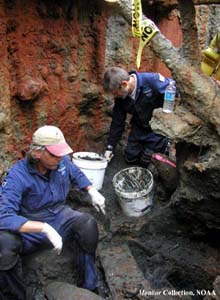
Jeff Johnston (L) and Dr. John Broadwater excavating the area behind the cannons inside the Monitor's gun turret. Click image for larger view and detailed explanation.
SPECIAL UPDATE on Human Remains
September 12, 2002
John Broadwater, Manager
Monitor National Marine Sanctuary
As previously reported, the remains of two Monitor sailors were recovered from the turret and sent to the U.S. Army Central Identification Laboratory in Hawaii (CILHI) for study. The CILHI archaeologist who has worked closely with us throughout the project reports that the remains are safely in storage at their facility, where they will be studied in an attempt to gain information that might lead to the identity of the individuals.
There has been a tremendous amount of interest in the two sailors who were found in the turret, and we are receiving lots of mail about them. Therefore, I want to provide a more detailed description of the procedures and protocols we are following with these sailors.
When planning the turret recovery expedition, we knew it was possible that we would find the remains of Monitor sailors within the turret, since that was the only way to exit the sinking ironclad. Therefore, we contacted the Naval Historical Center for advice, since the Center has been directly involved in the excavation of the Civil War submarine H. L. Hunley. We also consulted with the U.S. Navy's Mobile Diving and Salvage Unit Two, the unit that has been directing the Monitor recovery expeditions.
Acting on the Navy's advice and recommendations, we contacted CILHI. CILHI is the unit responsible for locating, recovering and studying the remains of U.S. service men and women from military sites around the world. CILHI produces a report on each individual brought to their laboratory and provides that report to the appropriate branch of military service (in the case of the Monitor, the U.S. Navy). There is then an effort to identify the individual and return the remains to the family. The family may request burial, with honors, at a military cemetery, or may choose to inter the person in a private cemetery of their choice.
Throughout the process, from initial discovery of the remains to transport of the remains to CILHI, NOAA and the Navy followed the written protocol developed by CILHI especially for Monitor Expedition 2002. In following this protocol, we were also adhering to the Geneva Convention, which calls for the remains of U.S. military personnel to be handled with dignity, respect, and honor.
All of us on the Expedition considered it an honor to be a part of the effort to return these long-lost men to a place of honor. A Navy Senior Chief on the Expedition expressed it best when he said, "We are often called upon to recover the bodies of military personnel who have been lost at sea in the line of duty. We should be pleased that our efforts have recovered the Monitor's famous gun turret, but we should also take pride and pleasure in bringing two of our lost shipmates home after 140 years."
We will continue to provide updates on our efforts to identify the two Monitor sailors. If you or someone you know has information that might assist NOAA and the Navy in returning these men to their families, please contact us.
Sign up for the Ocean Explorer E-mail Update List.

































